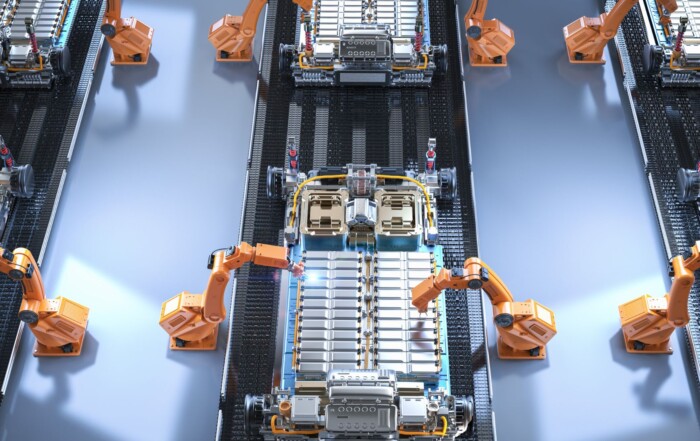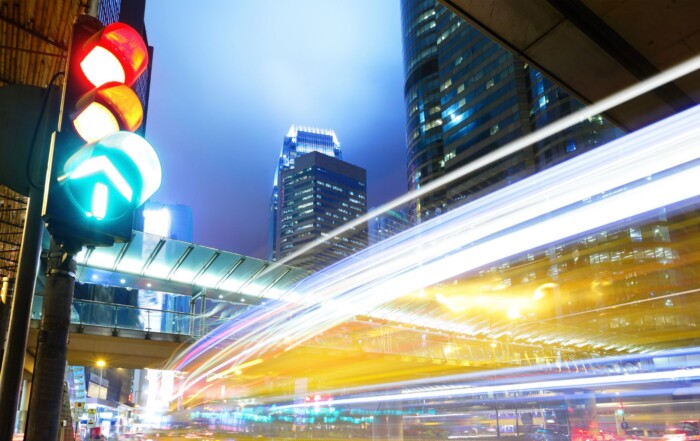Smart, Comfortable & Safe
How radar makes our everyday lives easier
Did you know that you probably appear on the screen of a radar sensor every day?
A wide variety of radar applications are nearly everywhere to be found. Almost every escalator or automatic door opener is equipped with a little sensor. The sensor will detect, for example, a person’s direction of movement and then open a door or start up an escalator. By means of electromagnetic waves, the equipment collects information about animate and inanimate objects within its detection range. Using this data, connected systems can be controlled intelligently and comfortably. Besides a significant boost in comfort, this also translates into a noticeable increase in efficiency. You can read below about how radar technology is making our everyday lives smarter, more comfortable and safer both in the future and already today.
SMART
Sometimes we tend to go a little overboard with lighting (especially during the Christmas season). In order to combat light pollution, however, the focus should be on efficiency. To go easy on the electricity bill, we should bear in mind the following: less lighting is more. But for many people, it isn’t always easy to consistently switch off needless power consumers. Conventional motion sensors operate based on the radar principle. If a person is in the room, only the relevant lights are switched on. When the person leaves the detection range, the lights are switched off. Some sensors also detect persons who are present but at rest. These variants prevent the light from suddenly being switched off when nobody in the room has moved for a while. Proximity switches also use radar. By moving their hand towards or away from such a switch, end users can control additional lighting elements in the room or adjust light intensity. Little displays showing the temperature or time on the stove are controlled efficiently and don’t light up when no one is in the room. We also encounter radar technology in technical installations such as heating systems. Here, it collects and transmits data regarding the presence or absence of room occupants. If there is no one in the room, the heating is turned down automatically. Models based on this principle exhibit significant energy savings. They can also help optimise the room climate. Radar-based control of air conditioning and ventilation systems operates in a similar fashion. Such a control system takes into account that the more people are in the room, the higher the devices must be turned up.
When combined with other sensors, radar can optimally adapt the energy consumption in rooms to occupants’ needs and boost efficiency considerably. Smart control thus yields tremendous savings on electricity and heating costs.
COMFORTABLE
After the smart use of the technology to raise efficiency, the next top priority consists in maximising comfort in building automation. Herein lies the most visible example of radar sensor technology: the automation of technical systems and devices. A classic in this sector is the door opener. This almost old-fashioned technological application is well-known from automatic glass doors in shopping malls and is now getting a makeover.
Cabinet doors, garden doors and room doors can be opened without saying the magic word. Equipped, radar-based motion sensors raise gates, open cabinets, swing open ramps or lock doors automatically.
The intelligent sensors also follow your movements: this feature allows technical elements in your vicinity to be controlled directly. This means, for instance, that no one is left in the dark – with light accompanying us wherever we go. Your morning coffee also gets a boost: the conventional time switch is combined with a motion sensor. This way, your machine doesn’t just greet you with “good morning” but even fills up your first cup of coffee as soon as you approach the kitchen. Everything is controlled on demand, in an automated and contactless manner.
Another area of application stems from the trends of the past few years. Smart technology has been appearing in our homes. Besides apps and internet access, manufacturers of electronic devices and household appliances also rely on sensors to boost their products’ capabilities in terms of orientation, interaction with humans or automation. While your little vacuum cleaner navigates its way through your house using infra-red or radar sensors, you can peruse the contents of your refrigerator on its door-mounted display and control it using gestures. These functions are likewise appealing in your living room and will find their rightful place in the smart home next to the increasingly popular voice control. Even smart, voice-controlled assistants rely on sensors in order to avoid having a drawn-out conversation with your cat.
Of course, not all measures are suitable in every situation or decisive for everyone’s personal sense of comfort. But certain benefits must be examined from a different angle: their value may reveal itself only in combination with a barrier-free home, for example.
SAFE
An increasing number of households have been equipping their homes with alarm systems in order to protect their property. The latest crime statistics reflect the results of these efforts. The number of successful break-ins is dropping, with intruders scared off by alarm systems. The functional principle of these security systems is usually quite simple. If a person enters the alarm detection zone while the system is active, a loud signal is sounded, alerting those in the vicinity of the intruder. Often times such products are equipped with mere PIR sensors. More complex systems may feature many more functions in combination with a radar sensor and offer much more than a conventional alarm system. Here as well, there is a trend towards technological functions such as imaging technology to ensure top-rate security. This way, tricky cases like roaming dogs, passers-by or weather conditions can no longer hinder the alarm from functioning reliably.
In the future, radar technology will increasingly take on further important, security-related tasks.
Sensors trigger reminders when occupants leave a building, switch devices on or off or anonymously monitor the behaviour of objects or people in the room – with the aim of facilitating users’ day-to-day lives. It is not only forgetful people or those with special care needs who can benefit.
Contactless control promotes a different aspect of safety: residents’ physical well-being. Contactless control via radar sensors boasts a clear hygiene advantage in your home. It is common knowledge that germs gather in places which frequently come in contact with your skin. In your home, these generally include door handles, light switches and taps. Integrating sensors into sanitary products like toilet seats or taps helps to prevent these microbial epicentres from forming.
While some radar-based applications have already successfully taken hold in our day-to-day lives, others still have a long way to go in terms of further innovation. Particularly by combining radar with other technologies, great synergy potentials can be achieved – for a smart, comfortable and safe future. The considerable benefits to end users yielded by radar technologies and combination systems justify the elaborate development work being carried out on the sensors. Demand is increasingly on the rise. Because radar isn’t just a short-lived trend. It is here to stay.
picture: ©ty – stock.adobe.com
Share this Content
Radar for Security Technology
Security of buildings, installations, outdoor and danger areas
Radar sensors successfully established themselves in the security industry years ago. Motion detectors in alarm systems, access controls and area monitoring use electromagnetic waves to secure premises, building complexes or properties. RADAR offers a wide range of solutions for various security requirements.


